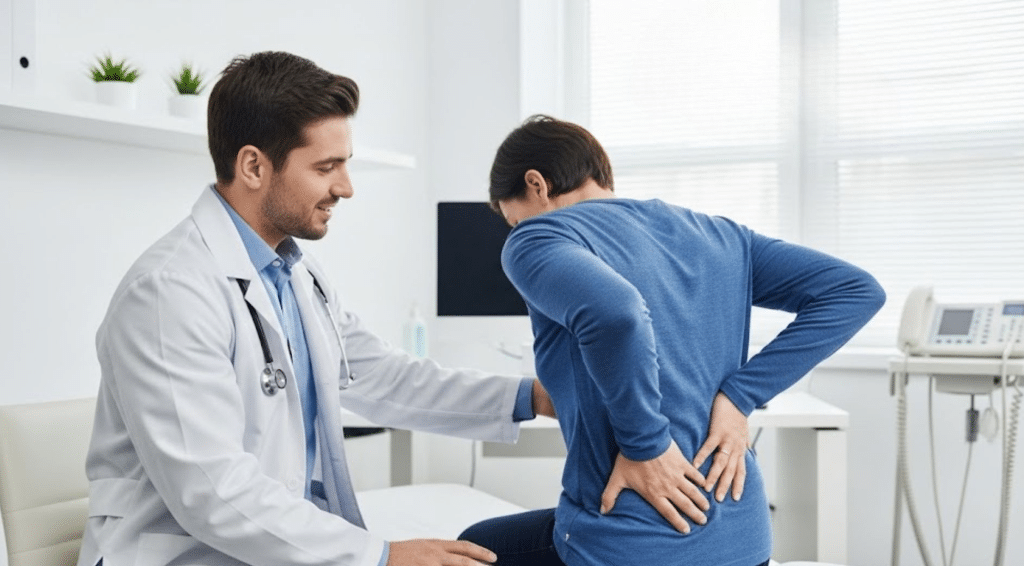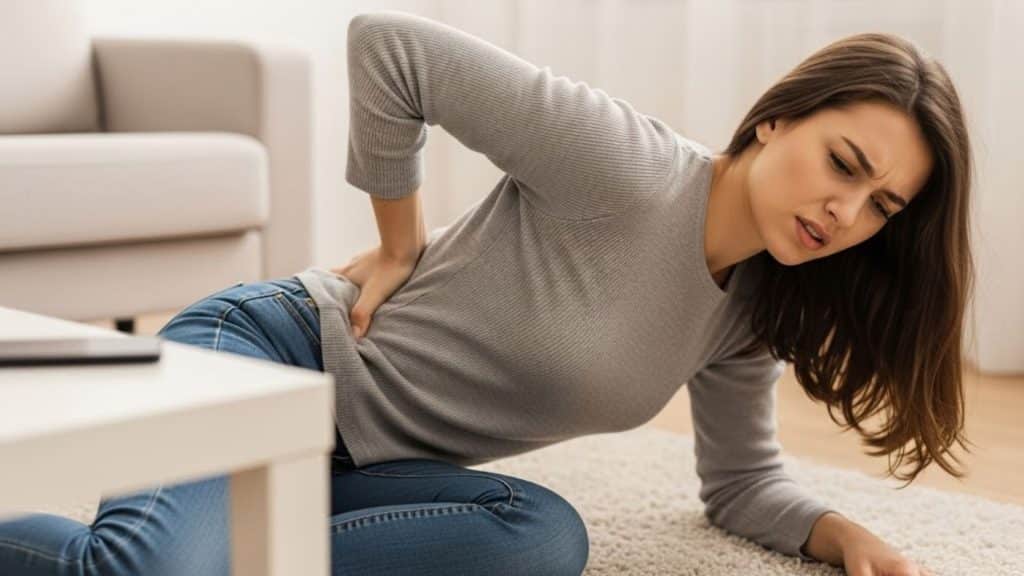Ever wake up with a sharp ache on just one side of your back? I’ve felt that too, and it’s not fun. Lower back pain on one side is more common than you might think, but figuring out what’s causing it can be tricky.
Sometimes it’s a simple pulled muscle, other times it could be a kidney issue or something more serious.
Today, I’ll walk you through the most common causes of right-side back pain, how to know if it’s something to worry about, and what actually helps.
You’ll also get tips on treatment, prevention, and when to check in with a doctor. Let’s figure out what your back pain might really mean and how to stop it from coming back.
Understanding Common Types of Back Pain
| Category | Details |
|---|---|
| Location | |
| Right Side (Lower Back) | May result from muscle strain, kidney issues, or poor posture |
| Left Side (Lower Back) | Can be linked to digestive problems or heart-related issues in some cases |
| Type of Pain | |
| Acute Pain | Starts suddenly, lasts a few days to a few weeks/months; often from injury or strain |
| Chronic Pain | Lasts 3+ months, recurs frequently, even after treatment; may need medical evaluation |
| Pain Sensation | |
| Sharp Pain | Often tied to injury or nerve compression |
| Dull Ache | May signal muscle fatigue, overuse, or underlying organ issues |
| When to Act | |
| Mild Symptoms | May respond to rest, ice/heat, and stretching at home |
| Persistent or Severe | Call a doctor if pain worsens, lasts over 3 months, or includes other concerning symptoms |
Common Causes of Right-Side Back Pain
Right-sided back pain can stem from various issues in your body. I know that lower back pain on one side is especially common and can indicate specific problems that may require different treatments. Here are some common causes:
1. Muscle Strain and Sprain
Your back muscles work hard every day, and sometimes they get overworked or injured. Lifting heavy boxes without bending your knees properly can strain these muscles painfully.
Sudden twisting movements while playing sports often result in muscle sprains that can cause pain for days. Poor posture in your desk job can cause constant stress on your back muscles over time. Even sleeping in a weird position can leave you with sore, strained muscles.
2. Kidney Issues
Your kidneys sit near your lower back, so kidney problems often cause back pain. Kidney stones cause sharp, intense pain that can make you feel nauseous.
Kidney infections cause a dull, aching pain along with fever and urination problems. These kidney issues typically hurt on one side of your back more than the other. The pain often worsens when you move around or press on the affected area.
3. Appendicitis
Your appendix sits in your lower right belly, but the pain can travel to your back. This happens especially when your appendix sits behind your large intestine in an unusual position. The pain usually starts near your belly button and then moves to the right side.
Back pain from appendicitis often comes with nausea, vomiting, and fever that gets worse quickly. This condition needs immediate medical attention since it can be very dangerous if untreated.
4. Spinal Problems
Your spine has many parts that can cause pain when they get damaged or worn out. Herniated discs happen when the cushions between your spine bones bulge out and pinch nerves.
Spinal stenosis occurs when the spaces in your spine get too narrow and squeeze nerves. Facet joints in your spine can get arthritis and become painful with movement. These spine problems often cause pain that shoots down your leg, too.
5. Other Conditions
Several other health problems can cause right-sided back pain that you might not expect. Infections in your spine or nearby organs sometimes create back pain along with fever. Digestive issues like gallbladder problems can make your back hurt on the right side.
Women might experience back pain from ovarian cysts or other reproductive system problems. Rarely, tumors or other serious conditions can cause persistent back pain that doesn’t improve.
How to Identify the Severity of Back Pain

Understanding how bad your back pain really is helps you decide what to do next.
- Mild pain that feels like a dull ache typically originates from muscle strain or improper sitting posture. You can often handle this type of pain with rest and gentle stretching at home.
- Moderate pain that throbs or is uncomfortable may signal kidney stones or spine problems. This level of pain deserves attention, but it isn’t always an emergency situation requiring immediate care.
- Severe pain that feels sharp, stabbing, or prevents you from moving requires immediate medical attention. This intense pain could mean serious problems like appendicitis or a badly herniated disc.
Pay attention to whether your pain improves or worsens over time.
Treatment Options for Right-Side Back Pain
Many different treatments can help relieve your right-sided back pain, depending on what’s causing it. Here’s a breakdown of the most common and effective treatment options available.
| Treatment Type | Options | What It Does | Best For |
|---|---|---|---|
| Home Remedies | Rest, ice/heat, pain meds, stretching | Reduces pain and inflammation | Mild muscle strains |
| Physical Therapy | Exercises, flexibility training | Strengthens muscles, prevents pain | Chronic issues, recovery |
| Medications | Anti-inflammatories, muscle relaxants | Controls pain and swelling | Moderate to severe pain |
| Surgery | Disc repair, stone removal | Fixes structural problems | Serious conditions only |
| Alternative Therapy | Chiropractic, acupuncture | Realigns spine, natural healing | Chronic pain, holistic care |
Most people start with home remedies and work up to stronger treatments if needed. Your doctor can help you select the most suitable combination of treatments for your individual situation.
Prevention Tips for Right Side Back Pain
Preventing back pain is much easier than treating it once it begins to hurt. These simple daily habits can keep your back healthy and pain-free for longer.
- Maintain a healthy weight: Excess weight puts stress on your spine and makes your back muscles work harder every day.
- Exercise regularly: Strong back and core muscles support your spine better and prevent injury during activities.
- Practice good posture: Sit straight, stand tall, and sleep with proper spine alignment to avoid strain.
- Lift properly: Bend your knees, not your back, when picking up heavy objects or boxes.
- Stay hydrated: Drinking plenty of water helps prevent kidney stones that can cause back pain.
- Use a quality mattress: A supportive mattress keeps your spine aligned while you sleep each night.
Making these habits part of your daily routine takes effort but pays off big time. Your back will thank you by staying strong, flexible, and pain-free for many more active years to come.
When to Seek Medical Attention

Knowing when your back pain needs professional help can save you from serious health problems. Some warning signs indicate that you shouldn’t wait around hoping the pain will go away on its own.
Severe pain that doesn’t get better even after resting for a day needs medical attention. If your back pain is accompanied by fever, chills, nausea, or vomiting, call your doctor immediately.
Blood in your urine or pain when you pee could signal kidney problems that need treatment. Pain that keeps getting worse over several days instead of improving is another red flag.
Conditions like appendicitis and kidney stones can become dangerous if you ignore them for too long. Trust your instincts and seek help when something feels seriously wrong.
Wrapping It Up
Right-sided back pain can be frustrating, but now you know what might be causing it and what to do about it.
Whether it’s a simple strain or something more serious, paying attention to your symptoms is key. I’ve given you tips to manage pain, prevent future flare-ups, and know when it’s time to see a doctor.
Even if you’re dealing with lower back pain on one side, small changes like better posture and daily habits can go a long way.
If you found this helpful, there’s more to learn. Check out my other blogs for easy-to-follow advice on pain relief, sleep, and everyday wellness. Your health matters, let’s keep working on it together.









